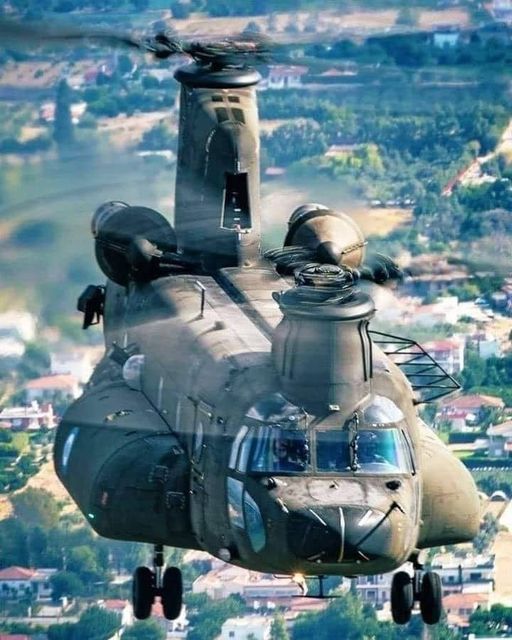8. Long Service

As well as the equally impressive fixed-wing Lockheed C-130 Hercules cargo aircraft, the CH-47 Chinook helicopter is one of the oldest aircraft in service in the United States military. While other US aircraft, such as the B-52 Stratofortress, are older, the Chinook is unusual in that it remains in service and in production.

The Chinook helicopter entered production in 1962 and has remained in production ever since. Over 1,200 have been produced.
7. Specifications

The Chinook has a crew of three, including the pilot, copilot, and a loadmaster or flight engineer. It can carry between 33-55 troops (although one British Chinook airlifted some 81 troops on one occasion during the Falkland War). It has a payload capacity of 24,000 lbs and a max takeoff weight of 50,000 lbs.

It cruises at 180 miles per hour but can reach speeds of 200 mph. Its service ceiling is 20,000 feet and it has a range of 450 miles.
6. Civilian Variant

The Chinook helicopter has a civilian variant called the Boeing Vertol 234. 13 of these Vertol 234s have been produced by Boeing. 6 of them were produced for British Airways Helicopters and another 3 were built for Helikopter Services AS in Norway. Interestingly, even Donald Trump once owned one before it was sold to Columbia Helicopters Intl.

Other Chinook helicopters found their way into civilian service when the Taiwanese Army transferred three of its Chinooks to the Taiwan Forest Service. The Taiwan Forest Service, in turn, leased them to Air Asia where they are used for cargo, SAR, passenger, and fire fighting services.
5. Abilities

The Chinook is able to reach a top speed of 200 miles per hour or 170 knots. Amazingly for a transport helicopter, that is faster than many of its original contemporary utility and even attack helicopters were able to do back in 1962 when it was first introduced.

For the all-important task for a cargo helicopter of loading and offloading, it has several ways of doing it. It has multiple doors from which cargo can be stored into its fuselage. It has a rear loading ramp. And finally, as we have all seen in the movies, it has three cargo hooks with which it can carry cargo underslung under the helicopter.
4. Disaster relief

The Chinook has proven to be very flexible and adaptable and its ability to carry heavy loads has made it particularly well suited to disaster relief operations. The Chinooks have been able to airlift a whole range of loads underslung under its fuselage into disaster zones.

They were used after the Boxing Day Asian tsunami in 2004, the 2005 Kashmir earthquake, the 2011 disaster at Fukushima, and in response to a number of hurricanes battering the US – among many other instances.
3. Modified To Respond In The Fukushima Disaster

Three of Japan’s Chinook CH-47 helicopters were employed to assist in cooling the reactors at Fukushima. They collected and dropped seawater on Reactors 3 and 4. In order to protect the pilots from the radiation from the power plant, the helicopters were equipped with lead plates.

They also had to keep their distance from the reactors to limit their radiation exposure and limit operations to 45 minutes over the site. Today, some 17 CH-47’s are in service in Japan’s Air Self-Defense Force in addition to 58 in service in the Ground Self-Defense Force.
2. Use In The Falklands War

During the brief Falklands War between the United Kingdom and Argentina, the Chinook was used in duties on both sides. In fact, both sides used four helicopters each. On the Argentine side, one from the Argentine Army’s service was shot down by the British by an RAF GR3 Harrier and another was captured and commandeered by the British.

On the British side, three of their Chinooks were destroyed in a single incident when the merchant ship the Atlantic Conveyor was struck by an Argentine Super Etendard (a sea-skimming missile). A further Six Westland Wessex helicopters and a Westland Lynx helicopter were lost by the British on the Atlantic Conveyor.
1. Variants

The CH-47 Chinook has been extensively updated and modified over the years for the changing face of modern war as well as to adapt for more and more roles within military service. These have been so successful that some militaries like Australia have replaced one older Chinook variant with a newer Chinook variant.

Some of the variants include the CH-47A, the ACH-47A through D, the MH-47D, and others. The CH-47J is a variant designed for the Japanese Self Defense Forces. The CH-47F is one of the variants that are still in production.
In summary, the Chinook’s service in supplying the US military on the frontline is set to continue for many years to come.
















